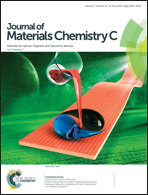An efficient green phosphor of Ce3+ and Tb3+-codoped Ba2Lu5B5O17 and a model for elucidating the high thermal stability of the green emission
Abstract
Green phosphors codoped with Ce3+ and Tb3+ have been studied extensively for application in UV-based white LEDs, but only few of them show both high luminescence efficiency and thermal stability. This study reports a new green phosphor of Ce3+ and Tb3+-codoped Ba2Lu5B5O17 prepared by a solid-state reaction. Emission color tuning from blue to green was studied as a function of Tb3+ concentration under UV excitation and well-described based on energy transfer from Ce3+ to Tb3+. The Tb3+ emission endowed the green phosphor with a high quantum yield of 86%, and a high thermal stability over the 303–483 K range was achieved. A model has been proposed to explain a general phenomenon observed in Ce3+ and Tb3+-codoped phosphors that Tb3+ emission is thermally more stable than the Ce3+ emission. A relationship between the temperature dependencies of Tb3+ and Ce3+ emissions was obtained in connection with room temperature energy transfer efficiency. The thermally stable Tb3+ emission was well-predicated using the obtained relationship. The new phosphor was employed for fabricating a UV-based white LED. A high color-rendering index of 91.4 at a low correlated color temperature of 3809 K is obtained, indicating promising application of Ba2Lu5B5O17:Ce3+,Tb3+ in solid-state lighting.



 Please wait while we load your content...
Please wait while we load your content...